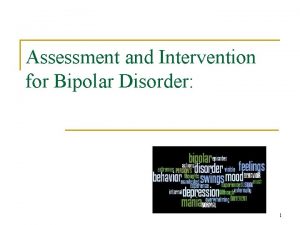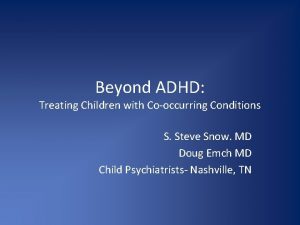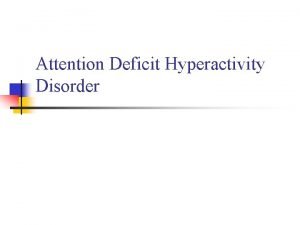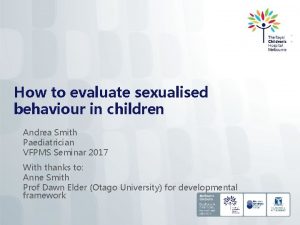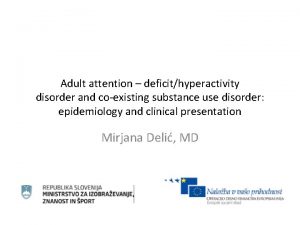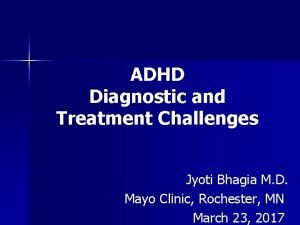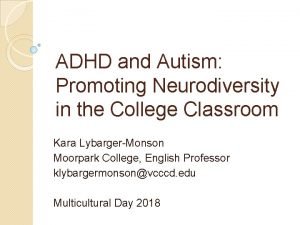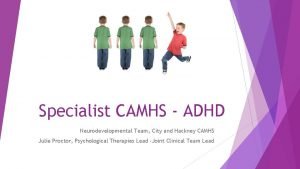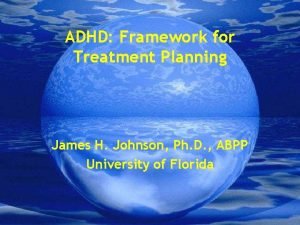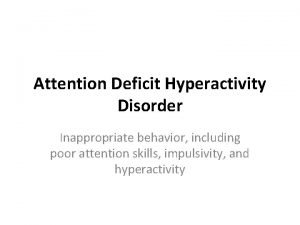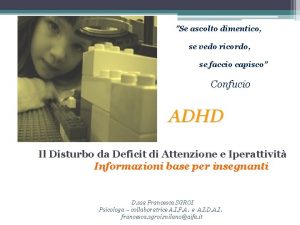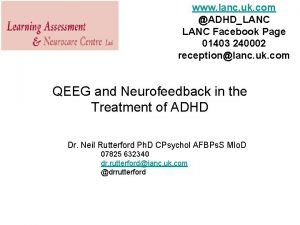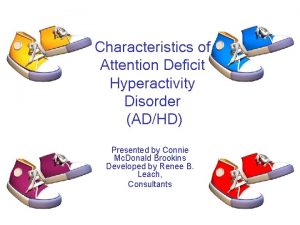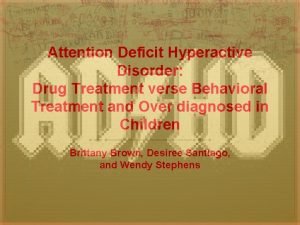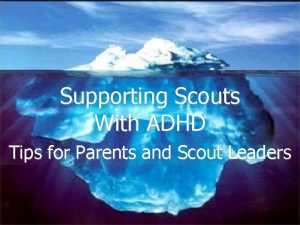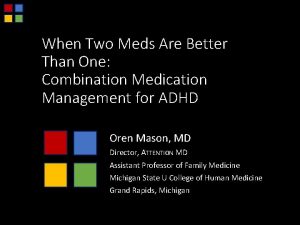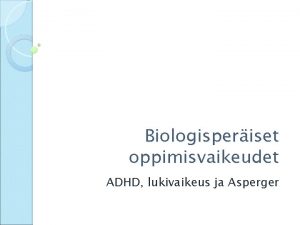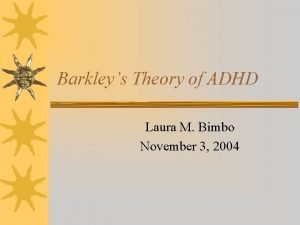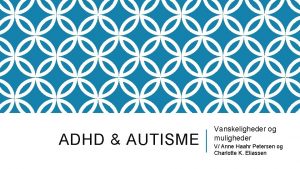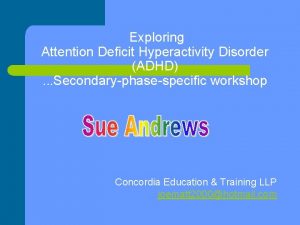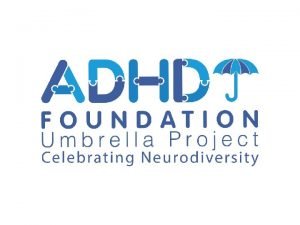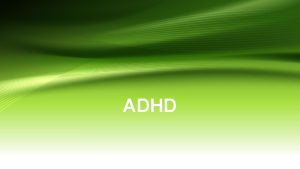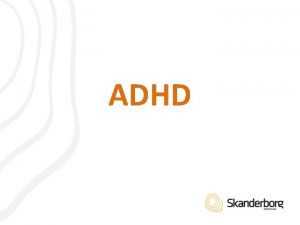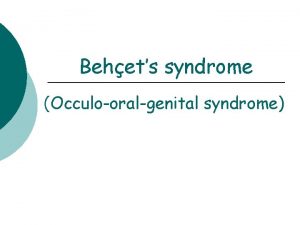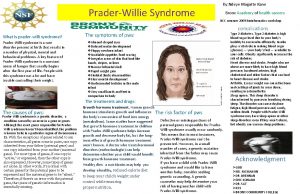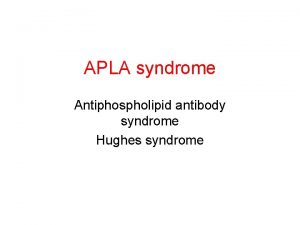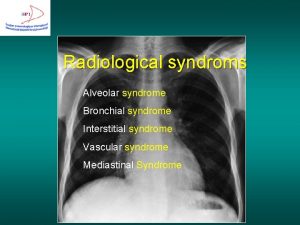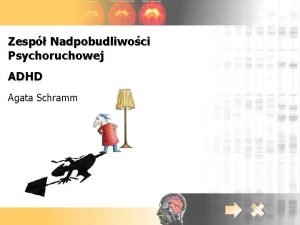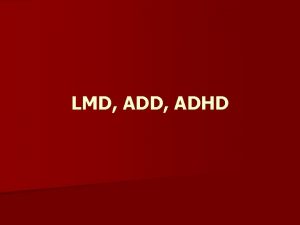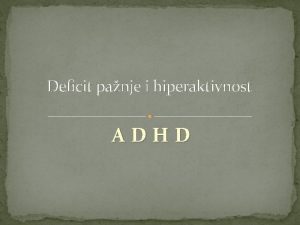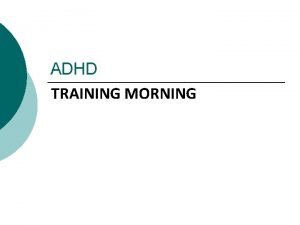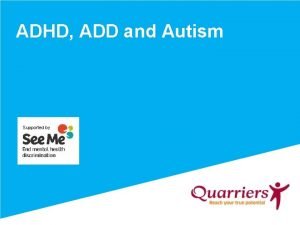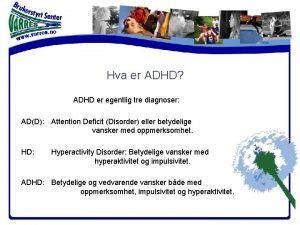ADHD What is ADHD ADHD is a syndrome


























- Slides: 26

ADHD

What is AD/HD? �AD/HD is a “syndrome of learning and behavioral problems characterized by difficulty in sustaining attention, impulsive behavior, and usually by excessive activity. ” (APA Style Guide, 7 th ed. ) �Point of some contention among psychologists: Whether AD/HD is a neurologically-based developmental disability or whether it’s a “fad diagnosis. ”

Types of AD/HD: DSM-IV-TR �Combined Type (both Inattentive and Hyperactive. Impulsive) �Predominantly Inattentive Type �Predominantly Hyperactive-Impulsive Type �Symptoms must be persistent before age 7. �NOTE: The term “ADD” is technically not correct. As of 1994, it is referred to as AD/HD Predominantly Inattentive Type.

Symptoms of Hyperactivity/Impulsivity (need 6+) Hyperactivity Impulsivity �Fidgets with hands or feet �Gets up from seat when inappropriate �Runs about/climbs when inappropriate (feeling of restlessness in adolescents/adults) �Trouble playing quietly �“On the go” or “driven by a motor” �Talks excessively �Blurts out answers before questions have been finished �Has trouble waiting one’s turn �Interrupts or intrudes on others

Symptoms of Inattention (need 6+) �Makes careless mistakes in schoolwork or work �Doesn’t pay close attention to details �Doesn’t seem to listen when spoken to �Doesn’t follow instructions; fails to finish work �Has trouble organizing activities �Often avoids or doesn’t want to do things that require sustained attention (schoolwork/homework) �Often loses things needed for tasks �Easily distracted �Often forgetful in daily activities

Children with AD/HD may have trouble controlling their impulses.

How is AD/HD diagnosed? �No simple test exists to give a definitive diagnosis. �Interviews with parents, teachers �Behavior rating scales (such as Connors) �Observation of the child �Psychological tests such as IQ tests and social/emotional tests �Tests such as quantitative EEGs, MRIs, and PET scans are NOT part of routine assessment but have been used in research.

Quant EEG findings in AD/HD �Most studies show excessive slow brain activity (theta waves) paired with a decreased fast brain activity (beta waves) �Theta waves—inattentive, dreamy state �Beta waves—seen when brain is very busy or engaged in a cognitive task �There’s great inter-individual variability. 47% do show increased theta, but only 5. 6% show decreased beta. 22% show increased beta waves, which requires a different treatment strategy.

Other brain differences �Children with AD/HD show decreased electrical and blood-flow activity in the frontal lobe and in other areas involved in attention, behavior inhibition, and motor control. �The brain volume of children with AD/HD is roughly 3% smaller than average.

Do children grow out of AD/HD? �Study by the NIMH in 2007 found that parts of the cortex mature more slowly in children with ADHD. �The lateral prefrontal cortex reaches maximum thickness at age 10. 5 in AD/HD children compared with age 7. 5 in children without it. �Some children do appear to “grow out of it, ” but some do not. It’s not understood why.

What causes AD/HD? �Presently unknown �There is a genetic predisposition. Genes involving neural communication have been implicated. �September 2009: An article in JAMA with adults with AD/HD showed lower dopamine receptor levels in the midbrain & accumbens (key dopamine receptor pathways) compared to controls. Low dopamine receptors were linked to inattention. �Prenatal exposure to alcohol, nicotine, or other drugs may increase the risk of ADHD. �Exposure to lead may increase the risk.

Stimulant medications �Stimulants such as Ritalin/Concerta are effective in 70 -80% of children with AD/HD. �Children with increased Beta activity as shown in QEEGs do not respond well to stimulants. �In general, children whose AD/HD involves frontal lobe inactivity respond to stimulants because the drugs appear to increase activity in the frontal lobe.

Special Diets and AD/HD �Research has shown that sugar is not related to AD/HD. �Restricted diets such as the Feingold Diet help about 5% of children with AD/HD. Most of these are very young children or those with food allergies.

Other Facts about AD/HD �Boys are 3 -9 times more likely to be diagnosed than girls are. �Children with AD/HD tend to score 7 -15 points lower on IQ tests than other children do, but this might reflect their inability to stay focused rather than a true intellectual difference. �About 10 -30% of gifted children have AD/HD, compared to 3 -5% in the general population.

Comorbidities and AD/HD �AD/HD is often seen in combination with other disorders, such as the following: �Depression �Anxiety �Obsessive-compulsive disorder �Oppositional defiant disorder �Drug and alcohol abuse: About 1/3 of children with AD/HD end up abusing drugs and alcohol during adolescence and adulthood.

Is AD/HD just a “fad diagnosis? ” Rogers H. Wright: Yes Michael Fumento: No � AD/HD is overdiagnosed. � No lab test for it. � Usually hyperactivity is a result of fatigue or emotional problems. � Behavioral interventions with parents are the best treatment. � AD/HD symptoms tend to disappear at adolescence. � Introducing a good male role model in single-parent homes can reduce the incidence of medication for AD/HD. Half of all medical conditions don’t have a diagnostic test. ADHD symptoms respond well to medical treatment. Studies show a genetic component. Studies show that kids who take Ritalin cut their risk of substance abuse by 50%. May be overdiagnosed, but in some populations (poor children, minorities), it’s underdiagnosed. Behavioral interventions with parents are not very effective.

Coping with a Child with AD/HD

Spanking It may feel like the right thing to do, but physical punishment and aggression do not work well with children with AD/HD.

AD/HD and “Spirit” �Children with AD/HD present with challenging behavior: explosive tantrums, inflexibility, hyperactivity, and intensity. �Lots of overlap between children with a spirited temperament and those with true AD/HD (Kurcinka, 1998) �Children with AD/HD would often be considered “difficult” children in Thomas & Chess’s model. �Medication alone is not sufficient. Effective parenting strategies are crucial.

Thomas & Chess’s Goodness of Fit model (1977) �Parents can change child’s temperament somewhat by using different parenting styles. �Difficult children need warm, sensitive, and consistent parents who are gentle but who make firm & reasonable demands. �Harsh parenting leads to conduct problems in difficult children. �Parents must respond sensitively and consistently to their difficult children’s needs to avoid behavior problems.

Explosive Tantrums � Also known as “spillover” tantrums (Kurchinka, 1998) � Different from manipulative tantrums � Explosive/spillover tantrums cannot be stopped; the child does not have control over them. � Punishing them for it is inappropriate and detrimental. � Goal as parent is to “stop the flood” and soothe child until he can regain control. Go to a quiet place with your child.

Greene’s “Explosive Child” �Explosive child is basically the same as a spirited child. �Greene says that “children do well if they can. ” �An explosive outburst occurs when cognitive demands being placed on a person outstrip his ability to cope. �Explosive kids lack certain “executive skills” (organizing, planning, separating emotional reactions from the thinking you need to do, controlling impulses, etc. ) �Common in children with ADHD, autism, and other developmental disorders.

Parents’ role (Greene’s model) �Parents have to function as their child’s executive center during explosive tantrums. �First: Avoid triggers for the tantrum if possible, even if it means “giving in” to the child. �Standard “behavioral management approach” (like Dr. Phil’s “going commando”) does NOT work with explosive children. Need a gentler approach. �Inflexibilty + inflexibility = explosion. Child can’t be flexible, so parent has to be until child learns those executive skills.

Greene’s Plans A, C, and B �Plan A: telling child “You must” or “You will. ” “Do what I said because I said so. ” Works with easy children but not difficult ones. �Plan C: opposite from Plan A; dropping the expectation completely, at least temporarily. E. g. , Don’t take explosive child to the grocery store. �Plan B: “Collaborative Problem Solving. ” Present problem to the child and ask for his input in how it should be solved. (Surrogate frontal lobe)

Keys to Success �Empathy—you must be able to see the world from the child’s perspective and have empathy for how he’s feeling. (Refer to Kochanska’s article about MRO: empathy in mothers played a key role in establishing MRO. ) �Another key—staying calm as much as you can. A reactive tantrum from the parent just makes the child’s tantrum worse.

What children with AD/HD need from teachers �Modifications: See what works and stick with it! �Allow child to get out of seat and walk around occasionally. �Do not take away recess as punishment. �Allow extra time on tests. �Let the child sit in a quiet area with as few distractions as possible. �Understand that many children with AD/HD also have anxiety. Be empathic.
 Hypomania adhd
Hypomania adhd Clonidine for adhd
Clonidine for adhd Adhd combined type
Adhd combined type Sexual behaviors examples
Sexual behaviors examples Adhd symptoms in women
Adhd symptoms in women Adhd prevalence by country
Adhd prevalence by country Uuuu_limited
Uuuu_limited Adhd test moorpark
Adhd test moorpark Hackney adhd clinic
Hackney adhd clinic Carlile centre
Carlile centre Adhd spiritual gift
Adhd spiritual gift Adhd treatment plan goals and objectives
Adhd treatment plan goals and objectives Difference between adhd and add
Difference between adhd and add Ascolto e dimentico vedo e ricordo
Ascolto e dimentico vedo e ricordo Lanc adhd
Lanc adhd Meaning of adhd
Meaning of adhd Combination adhd
Combination adhd Scouts adhd
Scouts adhd Combination adhd
Combination adhd Olivardia adhd sleep
Olivardia adhd sleep Ciri adhd
Ciri adhd Adhd oppimisvaikeudet
Adhd oppimisvaikeudet Bimbo theory
Bimbo theory What causes adhd
What causes adhd 9 h'er
9 h'er Caffeine and adhd
Caffeine and adhd Emma watson neurodiversity
Emma watson neurodiversity
